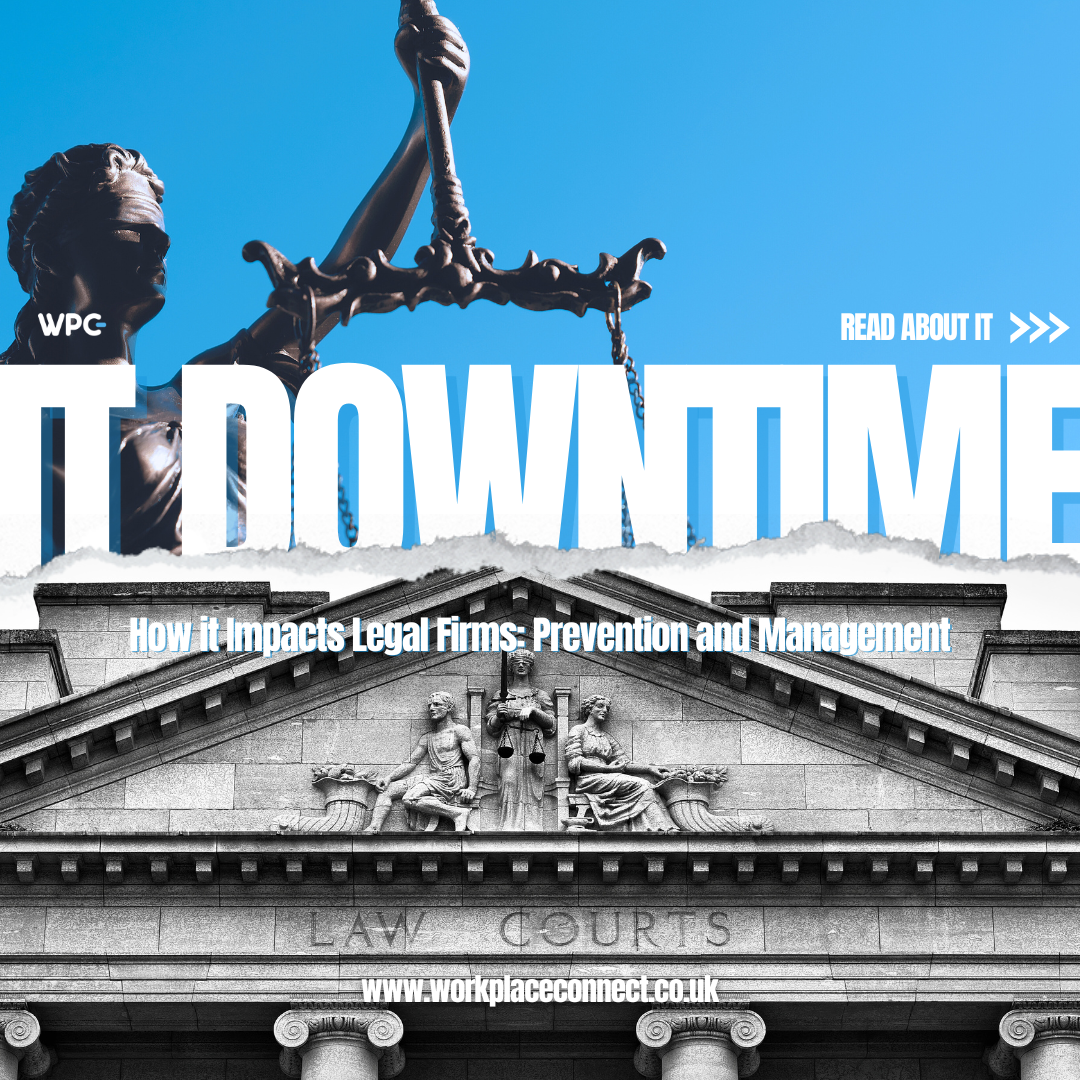In the current dynamic legal landscape, where businesses depend more and more on technology to run their operations, downtime of IT systems poses a serious danger to their organisation. Any time of IT outage can cause productivity disruptions, damage client relationships, and result in financial losses, regardless of the cause—cyberattacks, hardware issues, or plain old human mistake. This blog examines the different aspects of IT outages with an emphasis on how they affect legal practises. Our goal is to give legal professionals and company administrators a comprehensive understanding of the origins and effects of IT disruptions, along with practical solutions to protect their operations from these expensive disruptions. Legal firms may improve their operational resilience, uphold compliance, and get a competitive edge in a competitive market by comprehending the whole range of possible IT difficulties and taking a proactive approach to IT management.
The Gravity of IT Downtime
What is IT Downtime?
The term “IT downtime” describes times when IT systems are not available or are not operating as intended, which can seriously impair business operations. This includes unanticipated outages brought on by malfunctions or outside threats as well as scheduled downtime for system maintenance in the context of law firms.
Usual Causes of IT Downtime
Legal practises can improve the effectiveness of their mitigation efforts by having a better understanding of the common causes of IT downtime. Among these reasons are:
- Cyberattacks: Because legal businesses handle sensitive data, they are easy targets for cybercriminals. Ransomware attacks have the potential to seriously impair a company’s IT infrastructure and cause extensive downtime.
- Hardware Failures: Due to age or neglect, critical hardware components like servers and networking equipment might suddenly fail and cause service outages.
- Software Problems: Legal operations may be hampered by bugs, incompatible updates, or malfunctions in vital software (such as case management systems).
- Human error: Staff mishandling of IT resources, inadvertent deletions, or setup errors can result in lengthy outages.
- Natural Disasters: Although they happen less frequently, calamities like floods, fires, or extreme weather can harm physical IT infrastructure and interfere with power supplies.
Every one of these elements presents a different set of challenges, and the degree to which they have an influence depends on the firm’s readiness and reaction plans. Legal firms can minimise the negative consequences of IT downtime by better anticipating and responding to it by identifying and understanding these main causes.
The Effect of IT Downtime on Legal Practises
Financial Costs
IT outages have significant and varied financial consequences. Legal firms incur indirect expenses like late invoices and lost revenue, as well as direct costs like missed billable hours and attorneys’ inability to work on cases. The expenses of identifying and resolving the IT problems also exist; these may include high-priced technical assistance or urgent hardware replacements.
Direct Financial Costs
- Lost Billable Hours: IT outages can result in large financial losses for law firms, since billable hours are closely linked to income. Lack of access to computers or case management systems prevents attorneys from working effectively, which lowers billable hours and negatively affects the revenue of the company.
- Costs of Emergency Repairs: When IT systems malfunction, there may be a need for costly, urgent repairs. These include procuring replacement gear, employing outside IT experts for emergency interventions, and accelerating shipping and service costs to quickly resume operations.
Indirect Financial Costs
- Delays in billing: Cash flow can be negatively impacted by IT outages that cause delays in the preparation of bills and invoices. The inability of legal companies with narrow profit margins to pay for overhead such as office rent or personnel might be impacted by delays in receivables.
- Costs Associated with Client Retention and Acquisition: Downtime can damage the company’s reputation, which may result in the loss of present clients and make it more difficult to find new ones. Rebuilding trust and bringing in new business can come at a higher cost in terms of marketing and customer care.
- Opportunity Costs: Lawyers may lose out on new business during slow periods or neglect to address existing client demands in a timely manner. It would have been possible to pursue cases, negotiate settlements, or acquire new clients during the time spent recuperating from downtime.
- Increased Insurance Premiums: The cost of professional liability insurance may be greater for businesses that see regular outages. They could be seen as a greater risk by insurers because of possible claims brought about by data breaches or service interruptions.
Administrative and Staffing Costs
- Work Overtime: Employees may have to put in extra hours after a break in order to make up for lost time, which raises labor expenses.
- Staff Morale and Productivity: Regular IT problems can cause employee annoyance and bad morale, which can lower productivity overall and could result in greater turnover rates, which have their own expenses associated with hiring and training new staff members.
Operational Disruptions
IT outages cause multiple disruptions to a law firm’s key operations:
- Case Management Delays: It’s imperative to have access to digital information and case management systems. Downtime can affect case outcomes and client satisfaction by delaying court filings and making it more difficult to prepare for litigation.
- Communication breakdowns: Coordinating with clients, courts, and other members of the firm need dependable communication channels. Downtime might result in misunderstandings and missed deadlines, which can worsen the legal situation and harm professional relationships.
Compliance and Security Risks
Legal practises cannot compromise on adhering to regulatory norms. Depending on the client and case circumstances, IT outages may compromise the security of private client information, resulting in possible breaches and legal infractions under the GDPR or HIPAA protocols. In addition to the potential for penalties and fines, this could harm the company’s brand and cause long-term client trust concerns.
Client Trust and Firm Reputation
An attorney’s operational integrity immediately affects the firm’s capacity to uphold client trust. Due to the impression of unreliability, IT outages can cause client unhappiness and unfavourable evaluations, both of which can be disastrous in a cutthroat legal market.
Assess Your Weaknesses
Legal companies must be aware of specific IT risks because they have a direct influence on their capacity to secure confidential client data, maintain operational continuity, comply with regulations, deploy resources wisely, and preserve their brand. Recognising and addressing these vulnerabilities is crucial for both defending against present threats and becoming ready for new ones in the dynamic and complicated world of IT security. This section will walk legal companies through the steps of identifying essential systems, carrying out thorough risk assessments, and creating a Business Impact Analysis (BIA) to properly prioritise and remediate these vulnerabilities.
Risk Assessment Techniques
To reduce IT downtime as much as possible, legal companies must first be aware of their unique risks. Putting thorough risk assessments into practise can assist in determining where vulnerabilities exist and which threats have the greatest potential to affect their operations.
- IT Audits: An in-depth examination of the company’s IT infrastructure can be obtained through routine IT audits carried out by internal or external specialists. The strength of cybersecurity measures, the suitability of software solutions, and the condition of hardware should all be assessed during these audits.
- Vulnerability Scans: Automated technologies can be used to search the company’s networks and systems for weaknesses that hackers could exploit. Patch management and security enhancements are prioritised with the aid of these checks.
Identifying Critical Systems
Planning for contingencies and protection measures can be more targeted when one knows which systems are essential to the business’s operations.
Case Management Systems
- Essential Function: These systems are essential for handling client information, keeping track of deadlines, and managing all facets of a case from the beginning to the end.
- Priority Protection: Making sure there are strong security protocols in place and regular backups to guard against data loss or damage.
Communication Tools
- Essential Function: To provide efficient communication with clients and within the firm, tools like email, client portals, teleconferencing, and instant messaging are essential.
- Priority Protection: Putting in place failover and redundant systems to ensure that lines of communication stay open in the event of an IT outage.
Data Storage Solutions
- Essential Function: Safekeeping of legal documents, case files, and private client information.
- Priority Protection: Making use of geographically dispersed, encrypted storage options to guarantee that data is shielded from both online and offline dangers.
Document Management Systems
- Essential Function: These systems facilitate the effective organisation, archiving, and retrieval of legal documents. They are essential to preserving the availability and integrity of legal documents.
- Priority Protection: Making sure there is constant data synchronisation and quick recovery times in order to reduce downtime.
Financial Systems
- Essential Function: Systems that oversee payroll, billing, and other financial facets of the legal practise are essential.
- Priority Protection: To safeguard financial information and uphold operational integrity, stringent security procedures and backup plans must be put in place.
Client Relationship Management (CRM) Systems
- Essential Function: CRMs’ primary functions include tracking interactions, managing client connections, and maximising client engagement and retention.
- Priority Protection: To avoid data loss and maintain client service continuity, make sure these systems are frequently backed up and kept up to date.
Network Infrastructure
- Essential Function: All other IT operations are supported by the company’s servers, routers, and switches, which make up its internal and external communication infrastructure.
- Priority Protection: Preventing problems before they cause a large amount of downtime through routine maintenance, anomaly monitoring, and fast troubleshooting procedures.
Any contemporary legal practise must have these systems in place to function. Legal companies can customise their IT resilience plans to give these systems the utmost protection and precedence during IT planning and response activities by designating them as critical.







